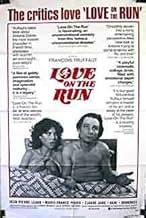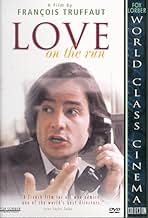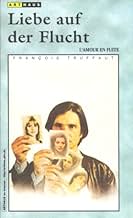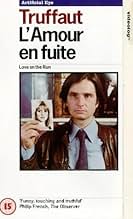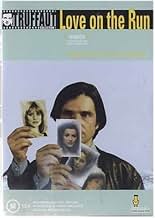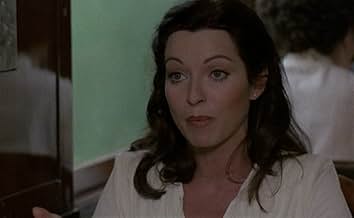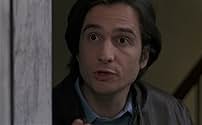Füge eine Handlung in deiner Sprache hinzuAntoine Doinel is now more than thirty. He divorces from Christine. He is a proofreader, and is in love with Sabine, a record seller. Colette, his teenager love, is now a lawyer. She buys An... Alles lesenAntoine Doinel is now more than thirty. He divorces from Christine. He is a proofreader, and is in love with Sabine, a record seller. Colette, his teenager love, is now a lawyer. She buys Antoine's first published autobiographical novel. They meet again in a station...Antoine Doinel is now more than thirty. He divorces from Christine. He is a proofreader, and is in love with Sabine, a record seller. Colette, his teenager love, is now a lawyer. She buys Antoine's first published autobiographical novel. They meet again in a station...
- Auszeichnungen
- 1 Gewinn & 1 Nominierung insgesamt
- Antoine Doinel
- (as Jean-Pierre Leaud)
- Sabine Barnérias
- (as Dorothee)
Empfohlene Bewertungen
"L'Amour en Fuite" is the conclusion of the sentimental saga of the character Antoine Doinel, the insecure alter ego of François Truffaut that began in "Les Quatre Cents Coups" and followed through "L'Amour à Vingt Ans", "Baisers Volés" and "Domicile Conjugal", inclusive with the use of scenes in the many flashbacks of these movies with his recollections and troubled love affairs. This character has an evolution from the needy fourteen years old boy rejected by his mother and his stepfather in the first movie. The lack of affection at home makes him a rebel, bad student, liar, reckless and a thief stealing objects and money at home in his adolescence. In the next movies, he grows-up, but with a fragile emotional structure and the viewer sees an unstable man incapable of having a steady relationship or commitment with the many beautiful women that he meets along his futile life. My vote is seven.
Title (Brazil): "O Amor em Fuga" ("The Love on the Run")
This particular stylistic device does set up a sense of familiarity for new viewers, however; with such a slight plot, the flashbacks end up becoming the most interesting part of the movie, with what little new footage there is so repetitive that it feels like you're watching the same scene over and over again. In fact, the film is so hastily put together that it looks like Truffaut is desperate to get the series finished and out of the way, so that he can finally move on with the more progressive work that he was attempting with films like The Green Room (1979) and The Last Metro (1980).
Still, the film can sometimes be charming and the actors are all on fine form, but the whole thing seems lacking somewhat; with the use of repeated imagery and scenes cut and pasted from the previous films making this feel too much like a retread rather than a radical re-interpretation. For me, the film just seems empty, deflated and somehow lacking the allure, beauty and sophistication that was always synonymous with Truffaut's work or at least the films of his that I am familiar with. For me, Love on the Run was something of a slight, disappointing and unimaginative film that failed to inspire me in the way I had initially hoped.
The plot and emotional growth of the character is excellent. So why only a 7 for this film? Well, much of the film is simply cut and pasted from the previous Antoine Doinel films. This gave it a certain cheap look. Plus, what I really found inexplicable was that Truffaut used clips from Jean-Pierre Léaud films that were NOT about Doinel but pretended the clips were about him. In addition, clips from some Doinel films were shown but the entire scene is re-dubbed or explained in a way in which the scene did NOT appear in the original film. A good example is a clip from Stolen Kisses. The narrator says he (Doinel) was unlucky in love and followed attractive women because he'd become infatuated with them. However, this scene was actually of Doinel following a lady because he was a private detective in this film--this was NOT someone he was infatuated with. Those who remember this movie well will be shocked at how easy it is to spot this obvious change. Finally, for some odd reason, one of the clips from Stolen Kisses is shown in black and white, while all the others from the movie are in color. It just didn't make sense why this occurred.
These inconsistencies are not great film-making. Decent film-making, maybe. For a better Truffaut film, try watching The Bride Wore Black (my personal favorite) or Wild Child or The Story of Adele H.
Wusstest du schon
- WissenswertesThe flashback of Liliane and Antoine arguing is, in fact, a clip from Die amerikanische Nacht (1973), in which both also played lovers despite the film not being part of Antoine Doinel saga.
- PatzerAccording to her grave, Antoine Doinel's Mother, Gilberte, died in 1971. According to the conversation Antoine has with her ex-lover five minutes before, she died in 1968 (while Antoine was in the army, in the beginning of "Baisers Volés").
- Zitate
[English subtitled version]
Antoine Doinel: [to Alphonse as he is about to head off to music camp] If you practice hard, you'll be a great musician.
Alphonse Doinel: What if I don't?
Antoine Doinel: If you don't, you'll wind up a music critic.
- Crazy CreditsDuring the opening credits, when the "Screenplay" ("Scenario de") credit appears on the screen, in the background a faded white "X" appears for a frame; also, there is a clapper on the left-hand side of the screen (for several seconds) before being pulled off screen.
Top-Auswahl
- How long is Love on the Run?Powered by Alexa
Details
Box Office
- Bruttoertrag in den USA und Kanada
- 509 $
- Eröffnungswochenende in den USA und in Kanada
- 11.206 $
- 25. Apr. 1999
- Weltweiter Bruttoertrag
- 509 $
- Laufzeit
- 1 Std. 34 Min.(94 min)
- Farbe
- Sound-Mix
- Seitenverhältnis
- 1.66 : 1

![Bande-annonce [OV] ansehen](https://m.media-amazon.com/images/M/MV5BZmU4NzU4Y2EtODg1ZS00NmVjLTlhOTItYWY2YmE0NTdlMDlhXkEyXkFqcGdeQXRyYW5zY29kZS13b3JrZmxvdw@@._V1_QL75_UX500_CR0)
